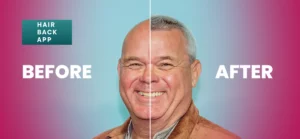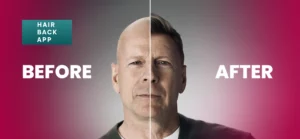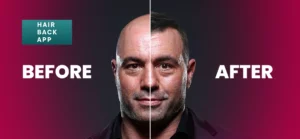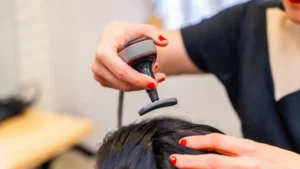Lupus, an autoimmune disease that affects millions worldwide, is as complex as it is enigmatic. Among its myriad symptoms, lupus hair loss stands out, not only for its prevalence but also for its impact on one’s sense of self.
Imagine waking up to find your hair thinning, your once-lush locks now a shadow of their former glory. It’s a reality for many individuals battling systemic lupus erythematosus (SLE), where the body’s immune system turns against its own tissues and organs.
My name is Emma Wright, your resident hair loss and restoration specialist. In this comprehensive guide, we delve into the intricate world of lupus hair loss, exploring its symptoms, treatment options, and the patterns it often manifests.
Whether you’re grappling with this condition firsthand or seeking insight into a loved one’s struggle, understanding lupus alopecia is a crucial step toward empowerment and effective management.
So, let’s embark on this journey together, shedding light on a topic often shrouded in uncertainty and offering hope for those navigating the challenges of lupus hair loss.
What is Lupus Hair Loss?
Lupus hair loss, medically referred to as lupus alopecia, is a common manifestation of systemic lupus erythematosus (SLE), an autoimmune disease characterized by the immune system attacking healthy tissues and organs.
While lupus can affect various parts of the body, including the skin, joints, kidneys, and heart, hair loss is one of the more visible and emotionally distressing symptoms for many individuals.
The exact cause of lupus hair loss is not fully understood, but it’s believed to be linked to inflammation triggered by the autoimmune response. This inflammation can disrupt the hair growth cycle, leading to thinning of the hair, bald patches, or in severe cases, permanent hair loss due to scarring of the hair follicles.
Lupus hair loss can vary widely in severity and pattern. Some people may experience gradual thinning of the hair on the scalp, while others may develop bald patches, particularly at the crown of the head. In some cases, individuals may also experience loss of eyebrow or eyelash hair, as well as thinning of body hair.
It’s important to note that lupus hair loss can be distressing not only due to its impact on physical appearance but also because it often serves as a visible reminder of the underlying disease and its unpredictable nature.
However, with proper management and treatment, including medications to reduce inflammation and suppress the immune response, many individuals with lupus hair loss can experience improvement in their symptoms and even regrowth of hair over time.
Lupus Hair Loss Symptoms
Lupus hair loss, or lupus alopecia, presents with various symptoms that can range from mild to severe. These symptoms may include:
- Thinning Hair: Gradual thinning of the hair on the scalp is one of the most common symptoms of lupus hair loss. Hair may become noticeably finer and less dense over time.
- Bald Patches: Some individuals with lupus alopecia may develop bald patches on the scalp, particularly at the crown of the head. These patches may vary in size and shape.
- Scalp Irritation: Itching, redness, or irritation of the scalp can accompany hair loss in lupus. This irritation may be due to inflammation associated with the autoimmune response.
- Eyebrow and Eyelash Loss: In addition to scalp hair loss, some people with lupus may experience thinning or loss of eyebrow or eyelash hair. This can contribute to changes in facial appearance and self-image.
- Body Hair Thinning: Hair loss may not be limited to the scalp; some individuals with lupus alopecia may also experience thinning of body hair, such as leg or arm hair.
It’s important to note that the severity and pattern of lupus hair loss can vary widely among individuals. While some may experience only mild thinning, others may develop more significant hair loss, including noticeable bald patches or even complete baldness in severe cases.
Lupus Hair Loss Patterns
Lupus hair loss, also known as lupus alopecia, can manifest in various patterns, ranging from mild to severe. Understanding these patterns can help individuals affected by lupus alopecia and their healthcare providers determine appropriate treatment strategies.
Here are some common lupus hair loss patterns:
- Diffuse Thinning: This is the most common pattern of lupus hair loss. It involves overall thinning of the hair on the scalp without distinct bald patches. Instead of losing hair in specific areas, individuals with diffuse thinning may notice that their hair appears less dense and lacks volume. This pattern of hair loss can be challenging to detect early on but may become more apparent over time.
- Scattered Bald Patches: Some individuals with lupus alopecia may develop scattered bald patches on the scalp. These bald patches can vary in size and location and may be surrounded by areas of normal hair growth. Unlike other forms of hair loss, such as alopecia areata, lupus-related bald patches are typically not perfectly round and may have irregular borders.
- Central Centrifugal Cicatricial Alopecia (CCCA): This is a specific pattern of hair loss that predominantly affects women of African descent but can also occur in individuals with lupus. CCCA typically starts at the central part of the scalp and spreads outward in a centrifugal fashion. Over time, affected areas may become scarred, leading to permanent hair loss. CCCA is often associated with inflammation and scarring of the hair follicles.
- Scarring Alopecia: In severe cases of lupus hair loss, scarring alopecia may develop. This pattern involves irreversible damage to the hair follicles, leading to permanent hair loss and scarring of the scalp. Scarring alopecia can result in smooth, shiny patches on the scalp where hair no longer grows. This pattern of hair loss is more common in individuals with long-standing or poorly controlled lupus.
- Eyebrow and Eyelash Loss: Lupus alopecia can also affect eyebrows and eyelashes, leading to thinning or loss of hair in these areas. This can contribute to changes in facial appearance and may cause distress for some individuals.

Lupus Hair Loss Treatments
Managing lupus hair loss can be challenging, but there are various treatment options available to help individuals cope with this symptom and promote hair regrowth. Treatment plans are often tailored to the severity of the hair loss, underlying lupus activity, and individual patient preferences.
Here are some common lupus hair loss treatments:
- Medications
-
- Corticosteroids: These medications, such as prednisone, can help reduce inflammation and suppress the immune system’s response, which may help control lupus activity and prevent further hair loss.
- Topical Corticosteroids: Corticosteroid creams or ointments applied directly to the scalp can help reduce inflammation and promote hair regrowth in localized areas of hair loss.
- Antimalarial Drugs: Hydroxychloroquine (Plaquenil) is commonly used to treat lupus and may also help reduce hair loss and inflammation associated with lupus alopecia. It’s often used in combination with other medications.
- Immunosuppressive Drugs: In cases of more severe or refractory lupus hair loss, immunosuppressive medications such as methotrexate, mycophenolate mofetil, or azathioprine may be prescribed to suppress the immune system and reduce inflammation.
- Biologic Therapies: Biologic medications, such as rituximab or belimumab, target specific molecules involved in the immune response and may be used in severe cases of lupus hair loss that do not respond to other treatments.
- Minimizing Scalp Irritation: Using gentle hair care products and avoiding harsh chemicals or excessive heat styling can help minimize scalp irritation and protect fragile hair.
- Hair Restoration Treatments: In cases of scarring alopecia or significant hair loss, hair transplantation or other surgical procedures may be considered to restore hair growth. These procedures involve transplanting healthy hair follicles from donor areas to areas of hair loss on the scalp.
- Scalp Massage and Stimulation: Gentle scalp massage and stimulation techniques, such as dermarolling or microneedling, may help improve blood circulation to the scalp and promote hair growth.
- Healthy Lifestyle Choices: Eating a balanced diet rich in vitamins and nutrients, getting regular exercise, managing stress, and avoiding smoking can all contribute to overall health and may help support hair growth.
Conclusion
In conclusion, lupus hair loss, or lupus alopecia, is a distressing symptom experienced by many individuals living with systemic lupus erythematosus (SLE). Understanding the symptoms, patterns, and treatment options for lupus hair loss is crucial for effectively managing this aspect of the disease and improving the quality of life for those affected.
While lupus hair loss can vary widely in severity and presentation, there are various treatment approaches available to help control inflammation, suppress the immune response, and promote hair regrowth.
Medications such as corticosteroids, antimalarials, immunosuppressants, and biologic therapies are commonly used to manage lupus alopecia, often in combination with scalp treatments and lifestyle modifications.
It’s essential for individuals experiencing lupus hair loss to work closely with their healthcare providers to develop a personalized treatment plan tailored to their specific needs and preferences. Regular monitoring and adjustments to treatment may be necessary to effectively manage lupus hair loss and minimize its impact on self-esteem and overall well-being.














